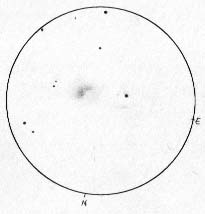 Popularly referred to as The Mice, NGC 4676 was immortalized in an image taken with a refurbished Hubble Space Telescope in spring 2002. I figure if it's good enough for Hubble, then it's good enough for me. Of course, my drawing doesn't quite match the detail captured by HST.
Popularly referred to as The Mice, NGC 4676 was immortalized in an image taken with a refurbished Hubble Space Telescope in spring 2002. I figure if it's good enough for Hubble, then it's good enough for me. Of course, my drawing doesn't quite match the detail captured by HST.
The Mice are huddled along the border with Canes Venatici about 1.5 degrees south-southeast of NGC 4656, the Hockey Stick. NGC 4676 appears as a tiny irregular patch in my 10-inch, f/4.5 Newtonian at 129X. Bumping up the magnification to 190X, they separate into the two galaxy cores. The southern galaxy's core is 60"x30" in size and aligned roughly east-west. A 10th magnitude GSC star shines about 6' due east. The northern galaxy's core is larger, 60"x45", aligned north-south and centered about 75" northwest of its companion. These are faint little stinkers with visual magnitudes in the 13.9 range, according to photometric data available online through the NASA/IPAC Extragalactic Database (NED). The Mice have a measured radial velocity of +6649 kilometers per second. This translates to a distance of approximately 332 million light-years, if the Hubble constant is assumed be 65 kilometers per second per megaparsec. |
![]()
![]()
